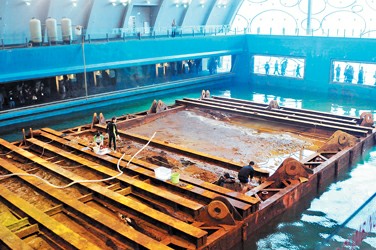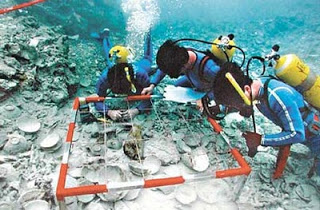Medieval History

A major underwater museum housing an 800-year-old merchant ship opened to the public in China this week.
The 30 meter wooden vessel, named Nanhai No 1, or South China Sea No 1, lies in a "crystal palace" made of glass inside the Maritime Silk Road Museum.
"Today marks a new journey for the ancient merchant ship," said Shan Jixiang, director of the State Administration of Cultural Heritage.
It was discovered early in 1987 off Hailing island of Yangjiang.
The debut of the ship will help Chinese scientists better conduct underwater archaeology and discover China's maritime and porcelain history, Shan said.
The ship has been kept in water, but the environmental conditions, including the temperature, constituents and pressure, remain the same as the waters where it was found, said Shan.
"The ship looks like it did before it was raised from the sea, and we built two underwater sightseeing corridors and a platform in the glass pool," Shan said.
The vessel was moved to the pool after it was salvaged from the sea two years ago.
The Guangdong provincial government invested nearly 200 million yuan ($29 million) for the construction of the 12,200-square foot museum, which started in 2005 and was completed last month.
It also displayed several hundred precious relics salvaged from the wreck. The exhibits are only a fraction of some 6,000 items, mostly porcelain, found during initial excavations between August and September.
"We hope more visitors can appreciate archaeologists' efforts in the discovery of the ship. The museum will allow more people to know more about rare and traditional Chinese treasures," Shan said.
From 1989 through 2007, underwater archaeologists conducted eight surveys and trial excavations of Nanhai No. 1, determining the ship?s measurements to be 30.4 meters in length, 9.8 meters in width, and 4 meters in height. It rested in one meter of silt beneath 25 meters of water. The hull was well preserved, although the upper structure no longer existed. The major parts, including the main deck, the sides, and the supporting structures, were basically intact. And, intriguingly, in a cabin elegant porcelain ware and metal articles were found to be neatly laid out.

It was believed that the salvage of Nanhai No. 1, the most important undersea archaeological discovery in China?s history, will offer significant material evidence for the study of the Maritime Silk Road, as well as the nation's history of seafaring, foreign trade, and shipbuilding.
Archaeologists found more than 4,000 gold, silver and porcelain artifacts, and about 6,000 copper coins while the ship was still on the seabed.
?Based on available information from he exploration, the entire ship is estimated to have 60,000 to 80,000 historical relics,? Wei Jun, research director from the Guangdong Underwater Archaeological Research Center, said.

The neatly arranged articles in the cabin suggested that these were the primary cargo. Further investigations were conducted in 2004, when a huge number of copper coins were collected, the majority from different reigning periods of the Northern Song Dynasty (960-1127), with a lesser number from the Sui (581-618) and Tang (618-907) Dynasties and the Five Dynasties (907-1127). The oldest dated back to the Eastern Han Dynasty (25-220 A.D.), and the latest to the Southern Song Dynasty (1127-1279). Hence it was deduced that Nanhai No. 1 sank sometime around the Southern Song.
Archaeological work on the site is expected to continue for up to ten more years.
The ship was recognized as one of the oldest and biggest merchant boats sunk in Chinese waters during the Song Dynasty (AD 960-1279) and might confirm the existence of an ancient maritime trade route linking China and the West.
A trade path linking the South China Sea and the Indian Ocean was opened as early as the Han Dynasty (206 B.C.-A.D. 220). Nevertheless, due to the limitation of navigational technology, merchant ships didn?t venture into far-ocean trading until the Song Dynasty (960-1279).
Besides the area?s frequent storms, the jagged coastline along the Maritime Silk Road between the South China Sea and the Indian Ocean held great peril for ships of the past, with many submerged reefs in wait of misguided wooden vessels. It is thought that these treacherous conditions likely led to the sinking of Nanhai No. 1.
- 800 Year Old Shipwreck Discovered In Baltic Sea
An 800-year-old shipwreck has been found by divers off the south coast of Sweden, prompting archaeologists to ponder the potential treasures inside. Lars Einarsson, underwater archaeologist at the Kalmar County museum, was amazed at the results of the...
- Shipwreck From Mongol Invasion Fleet Discovered Off Japan
Archaeologists from the University of the Ryukyus in Japan have discovered large parts of a Mongolian/Chinese ship that was likely part of the Mongol invasion fleet that tried to invade the island in 1281. The find is the first intact wreck related to...
- Ancient Arab Shipwreck Yields Secrets Of Ninth-century Trade
For more than a decade, archaeologists and historians have been studying the contents of a ninth-century Arab dhow that was discovered in 1998 off Indonesia?s Belitung Island. The sea-cucumber divers who found the wreck had no idea it eventually would...
- Couple Tomb Of Northern Song Dynasty Discovered In China
On October 20th, archaeological personnel discovered a husband and wife couple tomb of the Northern Song Dynasty in Changshan village, Jinkou Street, Jiangxia, Hubei Province. More than 20 pieces of unearthed artifacts, such as stone inkstone, pottery,...
- Archaeologists Find Ancient And Byzantine Remains On Cyprus
The results of several archaeological projects on Cyprus have been announced in recent days, which have revealed new details about an ancient merchant ship, a Hellenistic dance floor, and several communities which thrived during ancient and Byzantine...
Medieval History
800-year-old Chinese ship now on display in a museum

A major underwater museum housing an 800-year-old merchant ship opened to the public in China this week.
The 30 meter wooden vessel, named Nanhai No 1, or South China Sea No 1, lies in a "crystal palace" made of glass inside the Maritime Silk Road Museum.
"Today marks a new journey for the ancient merchant ship," said Shan Jixiang, director of the State Administration of Cultural Heritage.
It was discovered early in 1987 off Hailing island of Yangjiang.
The debut of the ship will help Chinese scientists better conduct underwater archaeology and discover China's maritime and porcelain history, Shan said.
The ship has been kept in water, but the environmental conditions, including the temperature, constituents and pressure, remain the same as the waters where it was found, said Shan.
"The ship looks like it did before it was raised from the sea, and we built two underwater sightseeing corridors and a platform in the glass pool," Shan said.
The vessel was moved to the pool after it was salvaged from the sea two years ago.
The Guangdong provincial government invested nearly 200 million yuan ($29 million) for the construction of the 12,200-square foot museum, which started in 2005 and was completed last month.
It also displayed several hundred precious relics salvaged from the wreck. The exhibits are only a fraction of some 6,000 items, mostly porcelain, found during initial excavations between August and September.
"We hope more visitors can appreciate archaeologists' efforts in the discovery of the ship. The museum will allow more people to know more about rare and traditional Chinese treasures," Shan said.
From 1989 through 2007, underwater archaeologists conducted eight surveys and trial excavations of Nanhai No. 1, determining the ship?s measurements to be 30.4 meters in length, 9.8 meters in width, and 4 meters in height. It rested in one meter of silt beneath 25 meters of water. The hull was well preserved, although the upper structure no longer existed. The major parts, including the main deck, the sides, and the supporting structures, were basically intact. And, intriguingly, in a cabin elegant porcelain ware and metal articles were found to be neatly laid out.

It was believed that the salvage of Nanhai No. 1, the most important undersea archaeological discovery in China?s history, will offer significant material evidence for the study of the Maritime Silk Road, as well as the nation's history of seafaring, foreign trade, and shipbuilding.
Archaeologists found more than 4,000 gold, silver and porcelain artifacts, and about 6,000 copper coins while the ship was still on the seabed.
?Based on available information from he exploration, the entire ship is estimated to have 60,000 to 80,000 historical relics,? Wei Jun, research director from the Guangdong Underwater Archaeological Research Center, said.

Archaeological work on the site is expected to continue for up to ten more years.
The ship was recognized as one of the oldest and biggest merchant boats sunk in Chinese waters during the Song Dynasty (AD 960-1279) and might confirm the existence of an ancient maritime trade route linking China and the West.
A trade path linking the South China Sea and the Indian Ocean was opened as early as the Han Dynasty (206 B.C.-A.D. 220). Nevertheless, due to the limitation of navigational technology, merchant ships didn?t venture into far-ocean trading until the Song Dynasty (960-1279).
Besides the area?s frequent storms, the jagged coastline along the Maritime Silk Road between the South China Sea and the Indian Ocean held great peril for ships of the past, with many submerged reefs in wait of misguided wooden vessels. It is thought that these treacherous conditions likely led to the sinking of Nanhai No. 1.
- 800 Year Old Shipwreck Discovered In Baltic Sea
An 800-year-old shipwreck has been found by divers off the south coast of Sweden, prompting archaeologists to ponder the potential treasures inside. Lars Einarsson, underwater archaeologist at the Kalmar County museum, was amazed at the results of the...
- Shipwreck From Mongol Invasion Fleet Discovered Off Japan
Archaeologists from the University of the Ryukyus in Japan have discovered large parts of a Mongolian/Chinese ship that was likely part of the Mongol invasion fleet that tried to invade the island in 1281. The find is the first intact wreck related to...
- Ancient Arab Shipwreck Yields Secrets Of Ninth-century Trade
For more than a decade, archaeologists and historians have been studying the contents of a ninth-century Arab dhow that was discovered in 1998 off Indonesia?s Belitung Island. The sea-cucumber divers who found the wreck had no idea it eventually would...
- Couple Tomb Of Northern Song Dynasty Discovered In China
On October 20th, archaeological personnel discovered a husband and wife couple tomb of the Northern Song Dynasty in Changshan village, Jinkou Street, Jiangxia, Hubei Province. More than 20 pieces of unearthed artifacts, such as stone inkstone, pottery,...
- Archaeologists Find Ancient And Byzantine Remains On Cyprus
The results of several archaeological projects on Cyprus have been announced in recent days, which have revealed new details about an ancient merchant ship, a Hellenistic dance floor, and several communities which thrived during ancient and Byzantine...
